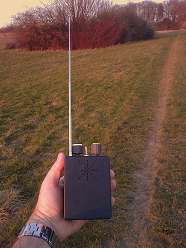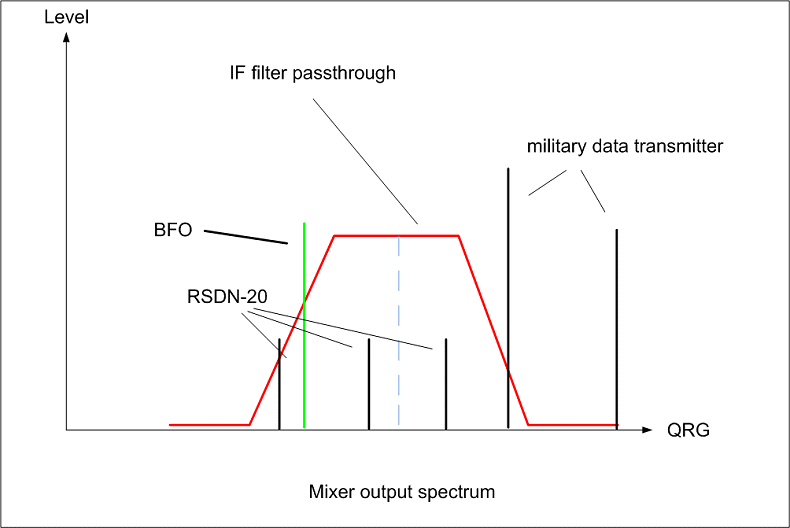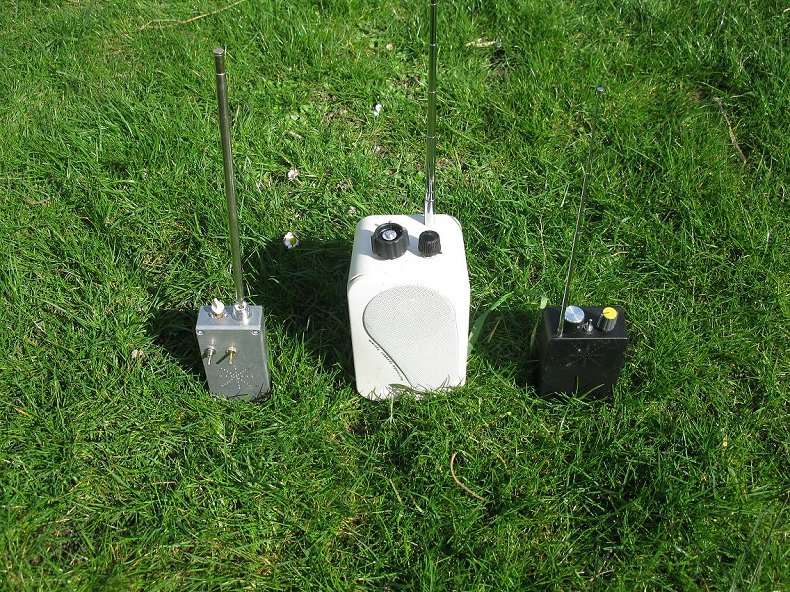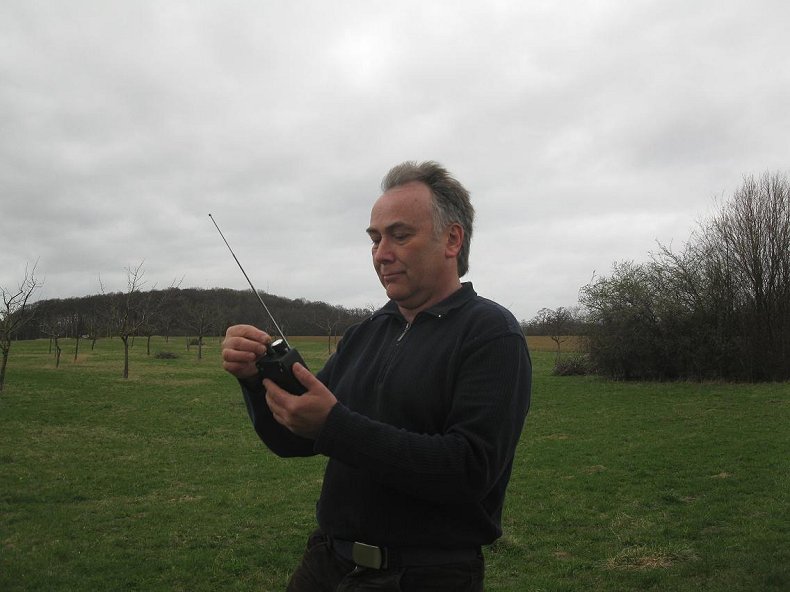 |
Detecting
and listening to VLF Signals became so easy
since most people own a notebook. A simple
peace of software combined with a wire antenna
connected to the soundcard's input is enough
to pick up VLF signals. Another method
listening to VLF signals is to convert them up
into a frequency range an amateur radio
transceiver or -receiver covers. All these
methods require long wire antennas and filters
for AM broadcast stations and sometimes
extensive additional equipment. But what should you do if you do not want to carry a notebook or other extensive RX components with long wires and so on every time? Wouldn't it be nice to have a small receiver which can be carried in the pocket to listen to VLF signals spontaneously? The following receiver concept may give an idea how to build a tiny and sufficiently performant RX without using expensive filters. |
Preliminary considerations
A VLF receiver needs a good selectivity. And the receiver must be able to detect CW signals like RSDN-20 and SAQ. Based on these requirements a superheterodyne RX with BFO can be a good choice. The first idea to get a good selectivity is using a very narrow IF filter. But these filters are very expensive and sometimes hard to get. The bandwidth of cheap ceramic IF filters is normally greater than 6 kHz, too much to separate the different signals sufficiently. An additional problem is the presence of very strong military data transmitters above 18kHz and the enormous RF level difference to the relatively weak RSDN-20 signals and, of course SAQ. One way to solve the problem may be to combine a cheap 6 kHz IF filter like CFU455HT or similar in the IF stage and a narrow audio filter after demodulation. While thinking about this idea more detailed, the next problem will occur. When you adjust the RX to the upper RSDN-20 transmitter at 14,88 kHz, the high power military data transmitters will pass the IF filter, too and will block the following IF amplifier. But even if this fact seems to be a knockout for the use of a cheap IF filter there is a way to solve the problem while using a trick. Nobody tells you to adjust the VFO so that the desired signal passes the IF filter exactly at it's center frequency. It is only necessary this signal will pass the filter somewhere. So you can adjust the RX VFO in a way the desired signal passes the filter on it's upper edge. The effect is the strong data transmitter signals above will be cut off because it is out of the passthrogh range, only signal rests will pass the filter. When the BFO frequency is adjusted to the lower edge of the filter transmission range, a major difference between the RSDN-20 audio signal for example and the unwanted signals above allows to extract the RSDN-20 with a narrow audio filter. The following picture shows the mixer output spectrum when the VFO is adjusted as described before.
 |
Building the receiver and functional description
A good way finding out which parts can be used is to
have a look into the component box. While lookin into
my box I found an old TDA4100 and a CFU455HT IF filter
which I had extracted from an old radio several years
before. The TDA4100 is not produced any more, but
still available at different suppliers. If you cannot
get a TDA4100, an equivalent type A4100D is available.
So the construction of the "receiver's heart" and some
additional ones to test if the result can be
reproduced was no severe problem. The rest of the
receiver could be built with common components. The
following schematic shows how the receiver works.

Click here for
full resolution scheme
For avoiding the use
of a long wire antenna, the first stage is a high
impedance preamplifier. With this stage a 30cm
telescopic rod antenna is enough to pick up the VLF
signals. A longer antenna will improve the
signal/noise ratio, but also may cause additional
problems. The reason is the increasing RF level which
can overdrive the mixer stage when using longer
antennas without level compensation. The preamp's
output is connected to the TDA4100 mixer input via a
potentiometer. This allows to adjust the mixer input
level in an optimal way.
The advantage in using an AM RX circuit like the TDA
4100 is the presence of a mixer, VFO, IF amplifier and
demodulator unit in one integrated circuit. Only a BFO
has to be added to hear the CW signals. For keeping it
simple, the BFO circuit is built around a 455 kHz
ceramic resonator. The frequency tolerance is quite
bigger than circuits using a crystal, so the BFO
frequency can be changed to several kHz away from the
center. In this special case, the BFO oscillates at
452kHz. The complete IF spectrum, BFO signal included,
passes the internal IF amplifier. The VFO is included
in the TDA 4100. It can be adjusted with a variable
capacitor extracted from an old radio or, like in this
example, with a varicap diode. The shown dimensions
allow to cover a frequency range from 0 to 150kHz, so
that higher frequent signals than VLF like time signal
and LF-remote control transmitters, LORAN, and DWD
Weather fax signals can be picked up with this
receiver, too. The demodulated audio signal is
available at Pin 19 where an audio low pass filter is
connected. Following the audio lowpass, there is an
additional audio bandpass filter. The combination of
the low-and bandpass-filter supresses the unwanted
military data signal rests passing the IF filter in a
sufficient way. The last stage is made with a LM
386-1, a very cheap audio amplifier circuit, to drive
a small loudspeaker. The circuit can be built in metal
or even plastic enclosures. The following picture
shows some suggestions.

The left receiver was installed into a common Hammond
die cast enclosure. The receiver in the middle was built
in an old PC loudspeaker housing and the right one was
made using a cheap ABS enclosure.
It is not necessary to create a PCB, a hole grid board
like shown below or even an ugly bug is ok. The only
important thing is to take care about proper grounding
all over the circuit to avoid oscillaton. An aluminium
foil below will reduce the capacitive effects caused by
the human hand while holding the receiver.

Reception results
Even if the circuit is very simple and using cheap filters, the weak RSDN-20 signals can be heard clearly when adjusting the receiver properly. It is necessary to listen in a clean VLF environment. Human made signals coming from switching power supplies and so on may cover the weak signals. Before writing the article, I could not test SAQ reception on 17,2kHz because the signal is very rare. It is only present for some minutes during 2-3 events in the year. But now, I could pick up the SAQ signal during transmissions in summer and winter time with good results. There were some weak interferences from the exorbitant strong data signals beside, but they were much weaker than the desired signals and no problem during listening.
 |
Thinking about improvements and schematic variations
The described receiver is a very simple one, made of cheap parts. It cannot give a performance even God cannot improve. The concept shall give an idea how to build a tiny VLF receiver which can be carried in the pocket for spontaneous VLF listening on several locations. There is much space for own ideas to make the receiver perfect. The described concept is no law how to build a tiny VLF receiver and what parts have to be used. Using AM receiver circuits will simplify the construction, but it is also possible to build a RX even using discrete components. On the other hand, the audio filters also can be built using integrated circuits and so on. As I said, there is a lot of space for own ideas. This circuit works well, but it is not the last spoken word.Following there are some possible ideas how to make the receiver better:
1. The 6 kHz IF filter bandwidth should not be increased, but there may be a way to narrow it. I found out there are 455kHz and 450 kHz IF filters with 6 kHz bandwidth available and still manufactured. If you combine these filters, the overlapping transmission ranges will result in a lower combined bandwidth. When doing this, you will have to pay attention to the resulting transmission attenuation in the passthrough range which may decrease the effect of narrowing the bandwidth a little bit. So an additional IF amplifier stage between the filters may become necessary.
2. The selectivity can be improved by adding a second audio bandpass stage.
3. Maybe it can be a good idea to play with the audio bandpass center frequency. You have to look at the whole system, beginning with the IF filter bandwidth and ending with the loudspeaker's frequency response.
4. A major problem is the audio feedback when adjusting the RX below 5 kHz at high audio levels. This cannot be avoided when concentrating all the parts in a small enclosure combined with high amplification values. So if you need high audio levels without the risk of audio feedback, it may be a way to separate the RX unit and the audio amplifier unit.
5. There is only one additional simple input filter to block strong broadcast stations in the MW range. It consists of a 1mH coil and a 100n capacitor. Combined with the lowpass consisting of the 680k resistors and the FETs internal capacity, that's enough to use the RX in a distance of 10km to a 20kW AM broadcast transmitter on 828kHz without interferences. But in some locations it may become necessary to use additional filters, like choking circuits or similar for suppressing image frequencies from strong AM radio stations in the MW range.
6. When using a varicap VFO adjustment, the tuning voltage has to be stabilized. This is a problem when using small 9V batteries. If you want to cover a frequency range up to 150kHz, a maximum tuning voltage around 6V is necessary. High audio levels will cause a battery voltage breakdown, so that the tuning voltage may breakdown, too. This will cause an unwanted frequency deviation. This can be avoided by using a separate small 12V battery with following voltage stabilisation to 6V.
7. An antenna length around 30cm is very short, but it works. For improving the signal noise ratio, a longer antenna will help. If you use a longer antenna, an additional capacitor in parallel to the FET's Gate will be necessary to avoid strong broadcast signals causing interferences.
8. For better fine tuning the BFO frequency can be made variable. This can be done by removing the ceramic resonator stabilized BFO and using a VCO instead. Or you can perform a fixed value variation by changing the 1,2nF capacitor in the BFO unit into other values.
9. The receiver can be changed quickly into a bat detector when using an ultrasonic microphone instead of the antenna. Such microphones are very rare to get, but some common microphones are sensitive in the ultrasonic range, even if they are specified only up to 22kHz. Maybe it is worth to test it.
Conclusions
The suggested receiver allows listening to VLF and LF signals in a clean VLF environment without hum. It is made of cheap and common components. A lot of space for own ideas is left. Please be careful when listening to VLF on the open field. Even if the crackling sound of ligthning strokes from all over the world can be heard in the range between 10kHz and 20kHz, it will be a good idea to go home when the crackling becomes louder. An appearing thunderstorm is very dangerous. VLF signals are fascinating, but the human life is fascinating, too.So have fun in picking up VLF signals.
Special thanks to Renato for providing his very excellent website.
Return to main Index of www.vlf.it